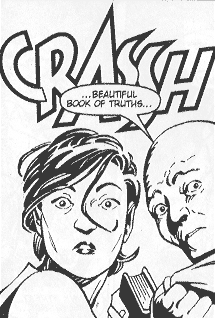 Written by Marc Bryant
Written by Marc Bryant
Art by Shepherd Hendrix
64 pages, black and white
Published by Image Comics
The music industry is like almost any other art form these days: a prime example of how the business side of art threatens to keep the creative side under lock and key. With iron-clad contracts, lawsuits, and bankruptcies getting more press than actual songs, it’s easy to see where writer Marc Bryant came up with the idea for Shangri-La, a story about when music goes horribly wrong…
Correy Stinson is the lead singer of Suplex… or rather, was. Replaced by his girlfriend who’s taken the band to new heights, Correy is untouchable in the music industry, leading him to finally agree on a last-ditch, desperate attempt for fame and glory. When it goes horribly wrong, though, Correy and assassin Jetta Helm are on the run from another killer sent by the most fearsome foe of all—Correy’s record label.
Bryant’s story is amusing, taking the idea of power-hungry record companies to a ludicrous extreme. There’s a nice sense of humor going on here, with Jetta’s list of things to do and Correy’s descent into obscurity. The basic ideas and plot behind Shangri-La are solid as well, and it would all come together if not for one thing: our protagonist. Correy Stinson’s an annoying idiot for the first two-thirds of Shangri-La, too obsessed with himself to really notice the rest of the world around him. It’s hard to work up any sympathy for his situation, and after a while you find yourself hoping that something bad really does happen to him. As a result, his sudden turn-around comes across as very hollow; it’s hard to believe that he’s changed, or even why he’s done so. Even the bits of information given towards the end to make you try and understand that he’s not such a bad guy don’t come across as convincing or really heartfelt. It’s a frustrating flaw in what could’ve been a much better book otherwise.
 Likewise, Shepherd Hendrix’s art is good, if not great. He’s got a strong understanding of the human body, and Hendrix can draw Correy Stinson’s sneer perfectly. Likewise, it’s easy to believe that Jetta could be an assassin, with her lithe body and commanding presence. The problem is really a lack of consistency. Hendrix looks great on one page, only to then having the next appear cartoonish (in a bad way) and hard to follow on the next. Little details like Correy’s facial hair shift on a regular basis (Is it a goatee? Sideburns? Full beard? Or all of the above?), and some of the action scenes seem remarkably stiff and unbelievable. It’s frustrating in part because it usually happens right after several really good-looking pages; if Hendrix’s art didn’t look so nice half of the time, it would probably be easier to ignore the lesser pages on display here.
Likewise, Shepherd Hendrix’s art is good, if not great. He’s got a strong understanding of the human body, and Hendrix can draw Correy Stinson’s sneer perfectly. Likewise, it’s easy to believe that Jetta could be an assassin, with her lithe body and commanding presence. The problem is really a lack of consistency. Hendrix looks great on one page, only to then having the next appear cartoonish (in a bad way) and hard to follow on the next. Little details like Correy’s facial hair shift on a regular basis (Is it a goatee? Sideburns? Full beard? Or all of the above?), and some of the action scenes seem remarkably stiff and unbelievable. It’s frustrating in part because it usually happens right after several really good-looking pages; if Hendrix’s art didn’t look so nice half of the time, it would probably be easier to ignore the lesser pages on display here.
A little weak in places, Shangri-La is none the less still enjoyable to read. It’s got a lot of really fun sequences, an amusing ending, and a nice low price-point to lure you on board. If this isn’t a movie just waiting to happen, I’m not sure what is. Cheaper than a new CD, Bryant and Hendrix are certainly ready to try and rock your world.
Purchase Links:
